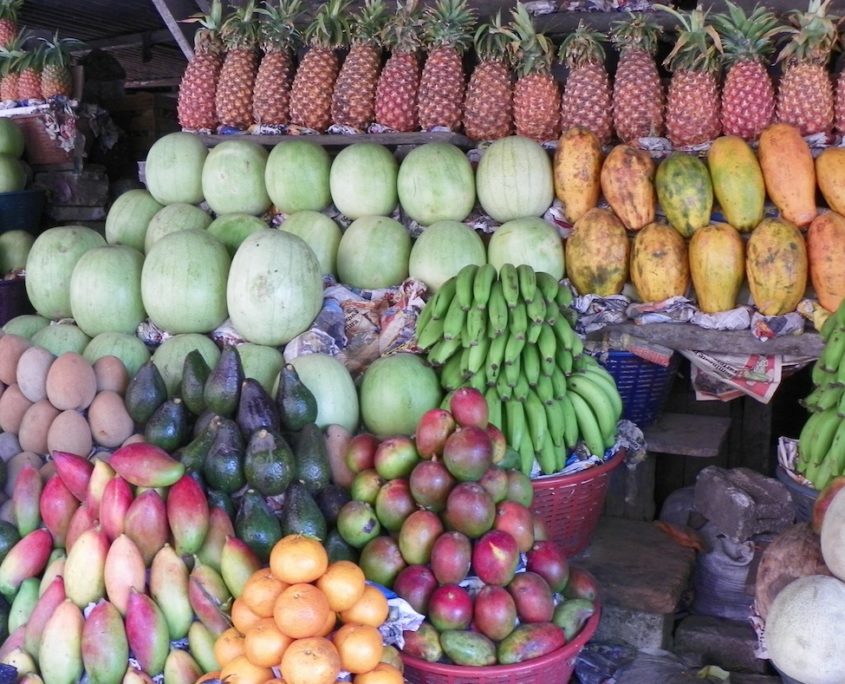Guatemala Fresh Fruits & Vegetables
Guatemala Fresh Fruits & Vegetables Storage suggestions and advice. Guatemala Fresh Fruits & Vegetables abound in quantity and quality in markets all over Guatemala. Visit the Antigua, Guatemala City, Livingston or Lake Atitlan markets and you are greeted with vendors of all types from Mayan women sitting on the ground to regular stall owners that one will see every day in the markets.

Guatemala Fresh Fruits & Vegetables
There are what is called regular market days, Solola, Chichi, Santiago, San Pedro, San Juan all have more or less featured market days. Solola, Antigua and Panajachel markets are open each day of the year.
The important point to consider about Guatemala Fresh Fruits and Vegetables Storage is the produce you are purchasing has never been refrigerated. Picked fresh from the fields loaded in a pickup and taken direct to the markets vendors for sale. In the Solola market you can see the pickups lined up out into the street waiting for their turn to drive into the market an unload their produce to sell.
WHY is this important, the first thing we do as expats and gringos is take these fresh fruits and vegetables home and put them into our Refrigerator and place them in the crisper for storage until the time of use.
WRONG. What you will find is most Guatemala produce does not do well in a refrigerator crisper. That head of Broccoli within a day turns yellow, Cauliflower head turns black and those red radishes are soft and mushy in a day. Carrots kept in a crisper will within a day take on a dark outer skin and become soft.
Guatemala Fresh Fruits & Vegetables Storage Suggestions

Guatemala Fresh Fruits & Vegetables
Tomatoes: love the heat and hate the cold. Turns out even after they’re picked from the vine, they still hold their aversion to cold. The fridge is not the ideal place to store tomatoes.
Potatoes: like cool temperatures. They do best at around 45 degrees F, which is about 10 degrees warmer than the average refrigerator. Keeping them in a paper bag in a coolish spot (like a pantry) is best. Why paper? It’s more breathable then plastic. Storing potatoes at cold temperatures converts their starch to sugar more quickly, which can affect the flavor, texture and the way they cook.
Onions: don’t come out of the ground with that protective papery skin. To develop and keep that dry outer layer, they need to be “cured” and kept in a dry environment like a pantry, which is not as damp as the refrigerator. Also, lack of air circulation will cause onions to spoil, as will storing them near potatoes.
Carrots: Greens should be trimmed off, all you have to do to keep the carrots crisp and fresh is put them in a container of water and store in the refrigerator! Whole carrots stay nice and crunchy in their cold water bath, and this is also a great way to store packaged baby carrots. If the water starts to look cloudy, just swap it out with fresh water as needed. Stored this way, carrots have lasted weeks in your refrigerator with no ill effects!
Strawberries: Wash strawberries only before eating them. This is important for two reasons. Strawberries are like sponges, so once wet, they soak up every bit of moisture, making them more likely to get mushy and spoil faster. Also, wet berries are more apt to get moldy. Leave the stems on as long as possible. Keeping the stems on until you’re about to eat the strawberries will prolong their shelf life. Refrigerate.
Papaya: Ripe papayas should be refrigerated to slow down the ripening process. Papayas will ripen within a few days at room temperature, and even faster if you put them in a paper bag. Once ripe, this fruit will quickly turn to mush if not properly stored.

Guatemala Fresh Fruits & Vegetables
Mangos: Keep unripe mangos at room temperature. Mangos shouldn’t be refrigerated before they are ripe. Mangos will continue to ripen at room temperature, becoming sweeter and softer over several days. To speed up ripening, place mangos in a paper bag at room temperature.
Once ripe, mangos should be moved to the refrigerator, which will slow down the ripening process. Whole, ripe mangos may be stored for up to five days in your refrigerator.
Broccoli and Cauliflower: Look for firm heads for both that have no hints of aging. Place the Broccoli and Cauliflower in a dark coloured plastic bag not tied or closed. Place at the front of your refrigerator on a lower shelf. You will find this will keep Broccoli and Cauliflower crisp for at least 5 days.
Peppers: Store in plastic bag in the vegetable crisper of your refrigerator. Green peppers will usually stay fresh longer than orange or red peppers.
Guatemala Fresh Fruits & Vegetables
What I prefer to do is shop for three days at a time for Guatemala Fresh Fruits & Vegetables. I keep produce that does not need to be refrigerated on the counter in my kitchen. And I follow these general rules about storage of Guatemala Fresh Fruits & Vegetables. It works.



 Joan Cass
Joan Cass 
 Lake Atitlan Tours
Lake Atitlan Tours 

 Grow Your Own Cure
Grow Your Own Cure